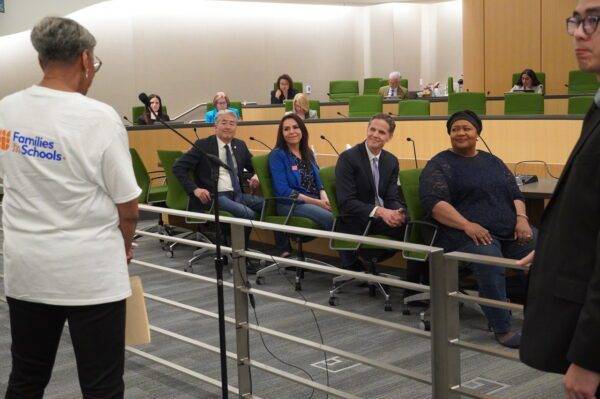From right to left: California Teachers Association Legislative Advocate Patricia Rucker, EdVoice CEO Marshall Tuck, Assemblymember Blanca Rubio (D-Baldwin Park), and Assemblymember Al Muratsuchi (D-Torrance) listen to public comments during an Assembly Education Committee hearing on AB 1454, held May 1. CBM photo by Antonio Ray Harvey.
Statewide — California is set to overhaul how it teaches reading to K-8 students after Gov. Gavin Newsom signed Assembly Bill (AB)1454, a landmark reform authored by Assembly Speaker Robert Rivas (D-Hollister) and supported by the NAACP California-Hawaii State Conference
The legislation requires the state to adopt new instructional materials and provides funding for professional development to train teachers in evidence-based reading instruction connected to the “science of reading.”
“Strong reading skills are the foundation for every student’s success, and this new law demonstrates a landmark commitment to advancing California’s reading and literacy rates,” Rivas stated. “It is a critical step forward and will improve literacy outcomes for all of our students.”
According to Rivas’ office, the new law is strengthened by a $200 million budget investment to equip California’s educators and school leaders with the training, materials, and support needed to help every student succeed.
Early literacy instruction is now being integrated into teacher credentialing and curriculum development, emphasizing evidence-based reading practices. Building on that effort, the state budget also allocates $250,000 to support guidance for adopting new instructional materials in line with AB 1454, Rivas’ office added.
“Our state is making a historic investment in our children’s future, showing its commitment and dedication to their success and well-being,” stated AB 1454 co-author Assemblymember Blanca Rubio (D-Baldwin Park).
AB 1454 represents the culmination of a multi-year effort to reform reading instruction in California. Its passage was delayed in part by a five-year campaign to shift teaching methods, and by earlier disagreements among stakeholders — including the California Teachers Association (CTA) and English learner advocacy groups — over the focus on a “science of reading” approach.
Those stake-holding organizations agreed to a compromise in April after months of negotiations. The compromise came when AB 1454 was revised to provide state-backed teacher training and align instructional materials with evidence-based reading methods.
Tonya Craft-Perry, an educator and member of the Black Parent Network, supported AB 1454. She traveled from Southern California on occasion to meet with lawmakers involved with the legislation.
Struggling with third-grade literacy disproportionately affects Black and Latino students — a gap that, Craft-Perry warned lawmakers, could push them toward the “school-to-prison pipeline.”
“We want students to be able to read and able to write, but also to understand how to use critical thinking skills, how to research, and know how to present information in a way that shows that they understand what they have read,” Craft-Perry said in May at the State Capitol.
Marshall Tuck, the CEO of EdVoice, one of the driving forces behind making the bill law, said that one-third of states have instituted evidence-based reading instruction into their early literacy policies, while California was falling behind.
Around 1.6 million students are enrolled in kindergarten through third grade, and 63% are from low-income communities across the state. About 75% are Black or Latino, and 34% are English learners. Only 2 out of 10 Black students were reading at a third-grade level, according to EdVoice.
“Some growth is modest, and some is profound, but in all cases the data reflects the impact of these investments and the hard work of educators to help students succeed,” said State Superintendent of Public Instruction Tony Thurmond. “We aspire to achieve even greater student outcomes. We are working to secure additional investments to support comprehensive, long-term, statewide strategies to further move the needle in student proficiency for years to come.”
According to 2024 information provided by the National Assessment of Educational Progress, California ranks 33rd in overall fourth grade reading proficiency. The state is also 39th out of 42 states for Black students, and 38th out of 48 for English learners.
“It is inspiring when students succeed. It lifts everything,” Tuck said. “What’s exciting is that our students are going to have more success next year and in the future. AB 1454 is about helping more children learn to read.”






